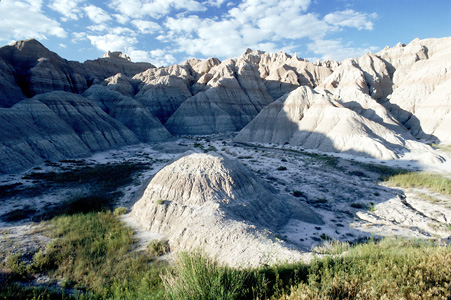Badlands National Park is in southwestern South Dakota. Its spectacular eroded landscape contains irregular ravines, ridges, low hills, and cliffs of many colors striped with grayish-white soil. Visitors can explore the park’s geological oddities, learn about prehistoric life in the area, and see bighorn sheep and other animals in their natural habitat.
The irregular landscape of Badlands National Park was formed by millions of years of geological processes. For tens of millions of years, layers of sedimentary rock , including shale , sandstone , and claystone, built up along river floodplains and in inland seas. Many layers included such sediments as silt and volcanic ash. About 500,000 years ago, the Cheyenne and White rivers began eroding the landscape.
The term badlands also is used to refer to regions of small, steep hills and deep gullies formed primarily by water erosion. Such badlands are found in many areas of the Great Plains and in other parts of the world. Most of these areas were formed of softer sedimentary rock than that found in Badlands National Park.
The landscape surrounding the park’s eroded formations consists primarily of mixed-grass prairie. Wildlife found there include bighorn sheep , bison , pronghorn , prairie dogs, hawks, and rattlesnakes. Paleontologists have discovered the fossilized remains of ancient alligators and rhinoceros, saber-tooth cats , and the ancestors of modern horses. Archaeologists have studied the remains of campsites in the area used by human hunters more than 12,000 years ago.
The Oglala Lakota people and other Native American groups lived in the Badlands area for thousands of years before European explorers arrived in the mid-1700’s. The Lakota called the area mako sica, meaning bad lands. French trappers who traded with the Lakota called it les mauvaises terres à traverser, meaning bad lands to cross. Today, the Pine Ridge Indian Reservation borders part of the national park. Congress authorized the purchase of land for the area in 1929. It was established as a national monument in 1939 and as a national park in 1978. For its area, see National Park System (table: National parks) .


